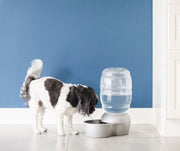Properly Storing Dry Pet Food

Once dry pet food is exposed to light or air, a process called “oxidation” occurs and food can become rancid very quickly. As pet parents, we know you spend a lot of money on your pet’s food, especially if it’s premium. That’s why learning how to properly store your pet’s food is very important.
All dry food bags come with a “best by” date on the bag, but what most people know is that this isn’t accurate once the bag has been opened. Once the bag has been opened the oxidation process has begun. The three factors that have an effect on the nutritional value of your pet’s food are air, moisture, and high temperatures. Here are some tips to keep dry food lasting longer.
Seal Your Bag
The FDA and pet food companies recommend that you seal your pet food because it minimizes the exposure to air, which can contaminate your pet food with bacteria.
To seal your bag, you can roll down the sides and use a bag clip to close up the bag. For extra protection, use an airtight container.
Store in a Cool, Dry Place
High temperatures can speed up the degradation process and cause the nutrients within the food to breakdown. You will want to avoid storing your dry dog food in places where temperatures can exceed 100 degrees such as a garage or shed.
Moisture can lead to mold which can cause your pet to be sick so where you place your pet’s food needs to be dry.
The chosen location should be in a secure place where your sneaky cat can’t climb up or your dog can’t break into it. Pet’s are never one to shy away from an extra dinner!
Airtight Containers
Storing your pet’s food in an airtight sealed container will preserve the freshness and will help keep it safe from bugs or rodents. It also keeps the smell contained which will be a bonus if you cool, dry place is in a common place such as the kitchen. The Vittles Vault line of pet food storage containers have the Gamma Seal Technology that provides the airtight seal that locks in the flavor and freshness our pet’s desire.
Keep the Container Clean
Many pet owners will dump a new bag of food into the container when it starts to run low. This is a bad idea. The oils from the kibble make the container greasy and you can get rancid oils from the old bag contaminating the new food. Thoroughly wash your pet’s container with hot, soapy water, then rinse, and completely dry before refilling the container. Excess moisture can cause mold and mildew to grow on the food which again can make your pet sick.
Every pet food is made with different ingredients, preservatives, and packing types so shelf-life and best-by dates may vary. Whether you buy dog food or cat food, use these tips to try and make the freshness and flavor last longer. When it comes to food when in doubt, throw it out.
Sources:
Previous article

Next article

Related posts
View all-

National K9 Veterans Day: Why and How to Celebrate
National K9 Veterans Day is celebrated every year on March 13th. This year its on Saturday March 13th, 2024. This day was established to recognize and celebrate the contributions that Military Working Dogs.
Read Article -

Puppy Training Tips
Training your pup from day one helps set a solid foundation for good behavior and a well-adjusted adult dog. Puppies thrive on structure, and a predictable routine makes learning easier.
Read Article -

Spring Cleaning Tips for Pet Parents
Say goodbye to the winter germs and hello to all the new spring smells! The beginning of spring is the perfect time to clean your house. For pet owners, this can mean more in-depth cleaning in areas other people don't have to worry about. We will give you some helpful tips and tricks so that cleaning up after your pet seems a little less daunting. Read Article



